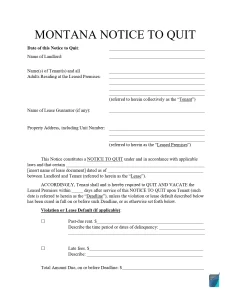Montana Eviction Notice Forms
The Montana eviction notice is a formal document issued by a landlord to begin the legal process of removing a tenant from the rental property. These notices must adhere to specific state regulations, which vary depending on the cause of removal.
Montana law requires all eviction notices to be in writing and to clearly state the reason for the action, the deadline for the tenant to respond, and the necessary steps to address the issue (such as paying overdue rent or rectifying a lease violation). If the tenant fails to comply with these stipulations, the landlord may proceed with filing a lawsuit in court.

Build Your Document
Answer a few simple questions to make your document in minutes
Save and Print
Save progress and finish on any device, download and print anytime
Sign and Use
Your valid, lawyer-approved document is ready
Montana Eviction Laws
According to Montana Code Annotated (MCA), Section 70-24-422, a landlord must provide a written notice to the tenant that specifies the acts and omissions constituting the noncompliance. The notice must also state that the rental agreement will terminate and require the tenant to vacate the premises by a certain date, which cannot be less than the minimum notice period stipulated by the law. Other main points outlined in this section include:
- Remediable violations. If the issue can be fixed (e.g., through repairs or payment), the tenant can remedy the situation before the specified date in the notice.
- Unauthorized pets or persons. An eviction related to unauthorized pets or individuals living in the unit requires a 3-day notice period.
- Other noncompliances. For violations not specifically categorized under other subsections, a 14-day notice is required.
- Recurring violations. If a tenant repeats the same violation within six months of a previous notice, the landlord may terminate the rental agreement with a 5-day notice.
- Severe violations. In severe breaches, such as verbal abuse toward the landlord, immediate termination can be enforced with a 3-day notice.
Furthermore, Section 70-24-422(1)(e) states that if the tenant remedies the violation within the notice period, the rental agreement does not terminate. This provides a fair chance for tenants to maintain their residency by addressing the issues cited by the landlord.
At the same time, Section 70-24-441 governs the termination of month-to-month tenancies, requiring either party to give at least 30 days written notice before ending the tenancy.
Montana Eviction Notice Laws Details
| Rent Grace Period | 3 days |
| Notice of Non-Payment | 3 days |
| Notice of Non-Compliance | 14 days |
| State Laws | Montana Code Annotated, Sections 70-24-401 to 70-24-442 |
Eviction Notice Types Used in Montana
In Montana, landlords use several eviction notices tailored to the specific reason.
3-Day Notice for Nonpayment or Other Violations
In Montana, landlords can issue a 3-day notice for serious breaches such as nonpayment of rent or substantial damage to the property. As outlined in Section 70-24-422 of the Montana Code Annotated, this notice also applies to other severe infractions, like verbal abuse toward the landlord, unauthorized pets, or persons residing in the unit. This notice demands tenants rectify the issue within three days or vacate the premises.
5-Day Notice for Recurring Violations
The situation escalates if a tenant receives a notice for a violation and then commits the same noncompliance within six months. In this case, the landlord is entitled to issue a 5-day notice to terminate the rental agreement. This shorter notice period, as specified under Section 70-24-422(e), underscores the severity of recurring violations and the tenant’s repeated failure to adhere to the rental agreement terms.
14-Day Notice for Lease Violations
Landlords must provide a 14-day notice for less immediate violations that do not fall under the categories warranting a 3-day notice. It includes issues like failure to maintain cleanliness standards or unauthorized changes to the property. This notice allows tenants two weeks to correct the violation as detailed in Section 70-24-422(d), offering a reasonable timeframe for rectification before eviction proceedings can commence.
30-Day Notice for Month-to-Month Lease Termination
According to Section 70-24-441, the landlord or the tenant can terminate a month-to-month rental agreement by providing a 30-day written notice. This notice does not require stating any cause for termination, thus allowing flexibility for landlords or tenants who wish to end the rental arrangement amicably and without specific reasons. This notice ensures that both parties have ample time to arrange new accommodations or find a new tenant.

Eviction Process in Montana
This process is governed by specific sections of the Montana Code Annotated, which ensures that both tenants’ and landlords’ rights are respected throughout.
Issue an Appropriate Notice
The first step in the eviction process is for the landlord to issue an appropriate notice, depending on the reason. Whether it’s a 3-day, 5-day, 14-day, or 30-day notice, this document must clearly state the reason for eviction and the timeline within which the tenant must act — either by remedying the violation or vacating the property.
Fill an Eviction Lawsuit
If the tenant fails to comply with the notice requirements (whether by not paying overdue rent, failing to rectify a lease violation, or not vacating the property), the landlord can then file an eviction lawsuit, also known as an action for possession. This step involves submitting the necessary paperwork to a local court and providing evidence of the notice given and the tenant’s noncompliance.
Court Hearing and Judgment
Once the eviction lawsuit is filed, the court will schedule a hearing, typically within 10 business days, although this can be expedited under certain conditions as outlined in Section 70-24-427(2). During the hearing, both the landlord and tenant will have the opportunity to present their case. The court will then issue a judgment based on the evidence and arguments presented.
Issuance of a Writ of Possession
If the court rules in favor of the landlord, it will issue a Writ of Possession, a legal order that authorizes the landlord to reclaim the rental property. The local sheriff’s department typically executes this writ, and the tenant must leave the property. The timeline for this step is strictly enforced to ensure swift resolution, as outlined in Section 70-24-427(4).
Execution by Sheriff
After the court issues the Writ of Possession, the sheriff must execute the writ within a specific timeframe, usually within 5 business days. This involves the sheriff physically removing the tenant from the property if they have not voluntarily vacated after the court’s judgment.

Use our document builder to customize any template on FormsPal to your preferences. Here is a number of some other widely-used Montana forms we provide.
Other Eviction Notice Forms by State